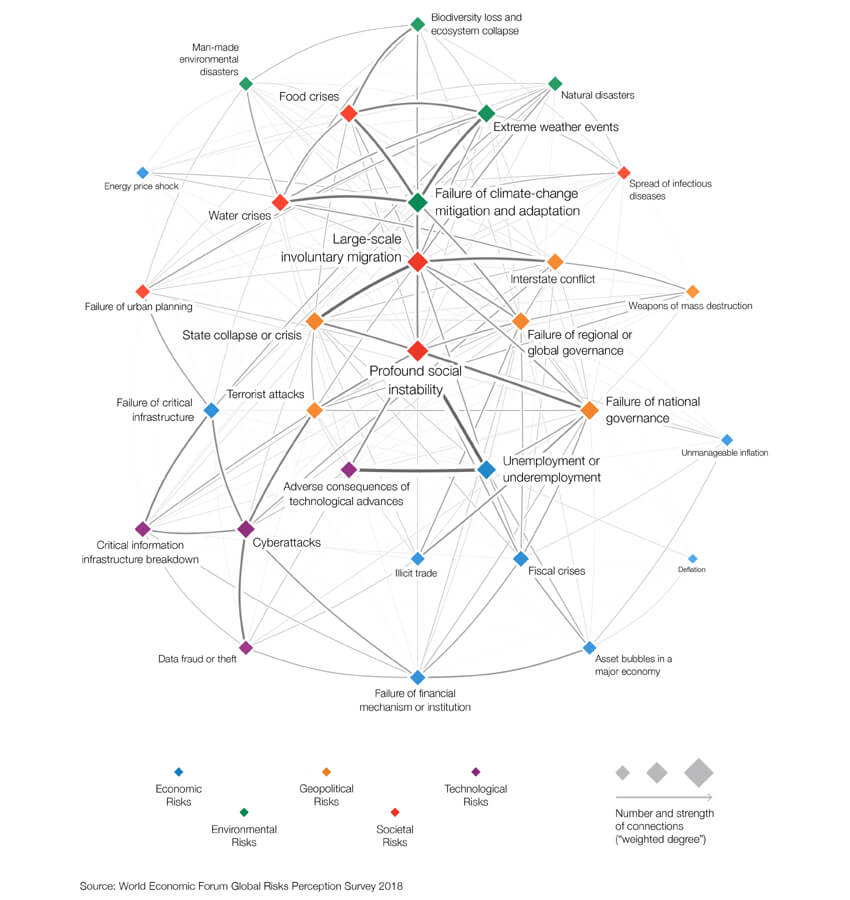How does climate change impact other sustainability issues?
We all know that climate change is a critical issue. But what about the other sustainability issues we are facing? Water scarcity and biodiversity loss, for instance, are two major problems also linked to food production. They are all immensely important – but there is a central reason why climate change is commonly identified as the risk of highest concern. These sustainability issues are interconnected and climate change has a strong effect on the others. More explicitly, the worse climate change gets, the worse these other issues will get as a result.
Let’s draw our square: Environmental sustainability comprises different impact categories including the examples mentioned above. These issues are under the same umbrella, in the same system, and they influence each other. Environmental sustainability overall is also under an umbrella of its own, in the same system as economic, societal, and geopolitical sustainability – and these are in turn interconnected. This is the playing field of the risks our society is out to reduce.
The pin in this square, however, is climate change. Take a look at the following graph from the Global Economic Forum visualizing the weight and interconnectivity of global risks before we dive deeper into some of them.

1. Water scarcity
Did you know that 17 countries, which are home to a quarter of the world’s population, face ‘extremely high’ water stress? [1] This means a shortage of surface and groundwater, which has implications for food security, migration, and financial instability. According to the UN, water was a major factor of conflict in 45 countries in 2017. [2] Water scarcity is clearly a problem with huge societal implications.
Why is climate change a major risk factor for water scarcity?
- According to the IPCC, as greenhouse gas concentration in the atmosphere increases, so does the fraction of the global population experiencing water scarcity. In existing dry regions, droughts will be an even more frequent occurrence.
- Climate change also causes rising sea levels. This leads to seawater intrusion of many natural freshwater resources along the coasts, making them unfit to consume.
- Finally, glaciers will shrink. This is a problem because glaciers act as freshwater reservoirs: They store water during cold or wet years and release it during warm years. As glaciers shrink, so do their meltwater yields during droughts and heatwaves.
2. Biodiversity loss
Biodiversity loss is for many a huge reason for concern, and rightfully so. The current rate of extinction is tens to hundreds of times higher than the average over the past 10 million years. The implications are serious and range from the collapse of food and health systems to the disruption of entire supply chains.
Nevertheless, the importance of biodiversity loss exceeds intellectual arguments. It breaks our collective heart when parts of nature that many of us ascribe an intrinsic value – birds, insects, mammals, and plants – are lost. Up until now, agriculture and fishing practices have been the main drivers of biodiversity loss. However, as climate change progresses, it is projected to become the most important driver. [3]
Newsletter to-go?
Our special today is our Newsletter, including snackable tips, hearty climate knowledge, and digestible industry news delivered to your inbox
How are different impact categories approached in an LCA?
If you want to address the problem of water scarcity, then you want to make sure you use water with caution. For instance, avoid cultivating crops with huge irrigation needs in water-scarce areas. But you also want to address global warming, since global warming will reduce the water supply in already water-scarce areas. Water use and Climate impact are two typical impact categories in LCAs. Which of these impact categories is most relevant for the problem of water scarcity can be hard to decide, but it also depends on value judgments, such as the importance of long-term versus short-term damage.
The same goes for biodiversity loss. A primary driver has been agriculture intruding on the natural habitat of wildlife, but it is also related to other typical impact categories in LCAs such as eutrophication, acidification, the spread of toxic substances, and finally climate change. Sustainability issues are often related to more than just one LCA impact category.
It can be challenging to decide which of the impact categories to focus on. It is equally difficult when two or more different environmental impact categories are weighed against each other. How bad is the extinction of ten species compared to insufficient water supply for agriculture in a season? This is the type of question food product owners need to answer if they wish to include many impact categories in a life cycle assessment and aggregate them into one single score. The answer depends on value judgments rather than science.
Related Posts
How do deforestation emissions work in food?
Deforestation is one of those topics that, as actionable and measurable as it is, transcends business and numbers. For most of us, images of thinning forests, the faded shades of green over the Amazon
Let’s talk scopes: Cradle-to-shelf or cradle-to-grave?
You have decided to calculate the climate footprint of your food product and perhaps also report it or share it with your consumers – great call, it’s a win-win. So, what should your scope be and
Allocation of emissions in food production
Making a climate footprint assessment can sometimes be difficult. The easy case is when you have one piece of land that produces one product. In those cases, you just sum up all emissions associated w
The CarbonCloud Third-Party Verification
Third-party verification is an important confidence boost in your climate footprints and strategy. So no wonder we get questions about it! Our clients –and their clients– are in it for full transp







